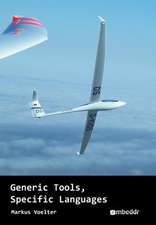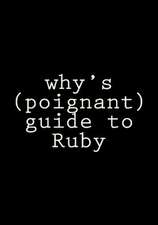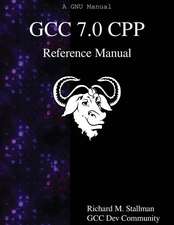Event-Driven Architecture: How SOA Enables the Real-Time Enterprise
Autor Advocate Taylor, Hugh, Angela Yochem, Les Phillipsen Limba Engleză Paperback – 31 ian 2009
Building on SOA, enterprises can gain even greater agility by implementing event-driven architectures (EDA) that automatically detect and react to significant business events. However, EDA planning and deployment is complex, and even experienced SOA architects and developers need expert guidance. In Event-Driven Architecture, four leading IT innovators present both the theory of EDA and practical, step-by-step guidance to implementing it successfully.
The authors first establish a thorough and workable definition of EDA and explore how EDA can help solve many of today's most difficult business and IT challenges. You'll learn how EDAs work, what they can do today, and what they might be able to do as they mature. You'll learn how to determine whether an EDA approach makes sense in your environment and how to overcome the difficult interoperability and integration issues associated with successful deployment. Finally, the authors present chapter-length case studies demonstrating how both full and partial EDA implementations can deliver exceptional business value. Coverage includes
- How SOA and web services can power event-driven architectures
- The role of SOA infrastructure, governance, and security in EDA environments
- EDA core components: event consumers and producers, message backbones, Web service transport, and more
- EDA patterns, including simple event processing, event stream processing, and complex event processing
- Designing flexible stateless events that can respond to unpredictable customers, suppliers, and business partners
- Addressing technical and business challenges such as project management and communication
- EDA at work: real-world applications ranging from real estate to healthcare, supply chains to flight control
Preface
Introduction
Chapter 1 EDA: Opportunities and Obstacles
Chapter 2 SOA: The Building Blocks of EDA
Chapter 3 Characteristics of EDA
Chapter 4 The Potential of EDA
Chapter 5 The SOA-EDA Connection
Chapter 6 Thinking EDA
Chapter 7 Case Study: Airline Flight Control
Chapter 8 Case Study: Anti-Money Laundering
Chapter 9 Case Study: Event-Driven Productivity Infrastructure
Preț: 276.27 lei
Preț vechi: 345.33 lei
-20% Nou
Puncte Express: 414
Preț estimativ în valută:
52.86€ • 55.19$ • 43.75£
52.86€ • 55.19$ • 43.75£
Carte tipărită la comandă
Livrare economică 05-19 aprilie
Preluare comenzi: 021 569.72.76
Specificații
ISBN-13: 9780321322111
ISBN-10: 0321322118
Pagini: 308
Dimensiuni: 230 x 180 x 18 mm
Greutate: 0.53 kg
Ediția:1
Editura: Addison-Wesley Professional
Locul publicării:Boston, United States
ISBN-10: 0321322118
Pagini: 308
Dimensiuni: 230 x 180 x 18 mm
Greutate: 0.53 kg
Ediția:1
Editura: Addison-Wesley Professional
Locul publicării:Boston, United States
Descriere
Improving Business Agility with EDA
Going beyond SOA, enterprises can gain even greater agility by implementing event-driven architectures (EDAs) that automatically detect and react to significant business events. However, EDA planning and deployment is complex, and even experienced SOA architects and developers need expert guidance. In Event-Driven Architecture, four leading IT innovators present both the theory of EDA and practical, step-by-step guidance to implementing it successfully.
The authors first establish a thorough and workable definition of EDA and explore how EDA can help solve many of today’s most difficult business and IT challenges. You’ll learn how EDAs work, what they can do today, and what they might be able to do as they mature. You’ll learn how to determine whether an EDA approach makes sense in your environment and how to overcome the difficult interoperability and integration issues associated with successful deployment. Finally, the authors present chapter-length case studies demonstrating how both full and partial EDA implementations can deliver exceptional business value. Coverage includes
Hugh Taylor is a social software evangelist for IBM Lotus Software. He coauthored Understanding Enterprise SOA and has written extensively on Web services and SOA. He holds an MBA from Harvard Business School. Angela Yochem is an executive in a multinational technology company and is a recognized thought leader in architecture and large-scale technology management. Les Phillips, VP, enterprise architecture, at SunTrust Banks Inc., is responsible for defining the strategic and business IT foundation for many areas of the enterprise. Frank Martinez, EVP, product strategy, at SOA Software, is a recognized expert on distributed, enterprise application, and infrastructure platforms. He has served as senior operating executive for several venture-backed firms and helped build Intershop Communications into a multibillion-dollar public company.
Foreword xi
Preface xii
Introduction 1
Event-Driven Architecture: A Working Definition 1
The “New” Era of Interoperability Dawns 6
The ETA for Your EDA 9
Endnotes 9
PART I THE THEORY OF EDA
Chapter 1 EDA: Opportunities and Obstacles 13
The Vortex 13
EDA: A Working Systemic Definition 14
The (Not So Smooth) Path to EDA 24
Defining Interoperability 26
Drivers of Interoperability 28
Application Integration: A Means to Interoperate 29
Interoperation and Business Process Management 31
Is There a Diet for All This Spaghetti? 35
How Architecture Promotes Integration 37
Management and Governance 39
Chapter Summary 43
Endnote 45
Chapter 2 SOA: The Building Blocks of EDA 47
Making You an Offer You Can’t Understand 47
SOA: The Big Picture 48
Defining Service 49
Service-Based Integration 50
Web Services 51
What Is SOA? 59
Loose Coupling in the SOA 60
Chapter Summary 61
Chapter 3 Characteristics of EDA 63
Firing Up the Corporate Neurons 63
Revisiting the Enterprise Nervous System 63
The Ideal EDA 78
BAM--A Related Concept 86
Chapter Summary 87
Endnotes 89
Chapter 4 The Potential of EDA 91
Introduction 91
EDA’s Potential in Enterprise Computing 91
EDA and Enterprise Agility 100
EDA and Society’s Computing Needs 102
EDA and Compliance 107
Chapter Summary 108
Chapter 5 The SOA-EDA Connection 111
Getting Real 111
Event Services 112
The Service Network 114
Implementing the SOA and Service Network 116
How to Design an SOA 122
The Real “Bottom Line” 134
Chapter Summary 137
PART II EDA IN PRACTICE
Chapter 6 Thinking EDA 141
A Novel Mind-Set 141
Reducing Central Control 142
Thinking about EDA Implementation 148
When EDA Is Not the Answer 151
An EDA Product Examined 153
Chapter Summary 157
Endnotes 158
Chapter 7 Case Study: Airline Flight Control 159
Learning Objectives 160
Business Context: Airline Crunch Time 160
The Ideal Airline Flight Control EDA 167
What FEDA Might Look Like in Real Life 176
Program Success 197
Chapter Summary 206
Endnotes 207
Chapter 8 Case Study: Anti-Money Laundering 209
Learning Objectives 210
Cracking a Trillion Dollar, Global Crime Wave 210
IT Aspects of Anti-Money Laundering 216
EDA as a Weapon in the War on Money Laundering 221
Chapter Summary 259
Endnotes 260
Chapter 9 Case Study: Event-Driven Productivity Infrastructure 261
Learning Objectives 262
The Often Inadequate Human Link in the EDA 262
Overview of Productivity Infrastructure 264
The Potential Benefits of EDA-PI Integration 267
ProdCo, an EDA-PI Integration Scenario 273
Chapter Summary 293
Endnotes 294
Going beyond SOA, enterprises can gain even greater agility by implementing event-driven architectures (EDAs) that automatically detect and react to significant business events. However, EDA planning and deployment is complex, and even experienced SOA architects and developers need expert guidance. In Event-Driven Architecture, four leading IT innovators present both the theory of EDA and practical, step-by-step guidance to implementing it successfully.
The authors first establish a thorough and workable definition of EDA and explore how EDA can help solve many of today’s most difficult business and IT challenges. You’ll learn how EDAs work, what they can do today, and what they might be able to do as they mature. You’ll learn how to determine whether an EDA approach makes sense in your environment and how to overcome the difficult interoperability and integration issues associated with successful deployment. Finally, the authors present chapter-length case studies demonstrating how both full and partial EDA implementations can deliver exceptional business value. Coverage includes
- How SOA and Web services can power event-driven architectures
- The role of SOA infrastructure, governance, and security in EDA environments
- EDA core components: event consumers and producers, message backbones, Web service transport, and more
- EDA patterns, including simple event processing, event stream processing, and complex event processing
- Designing flexible stateless events that can respond to unpredictable customers, suppliers, and business partners
- Addressing technical and business challenges such as project management and communication
- EDA at work: real-world applications across multiple verticals
Hugh Taylor is a social software evangelist for IBM Lotus Software. He coauthored Understanding Enterprise SOA and has written extensively on Web services and SOA. He holds an MBA from Harvard Business School. Angela Yochem is an executive in a multinational technology company and is a recognized thought leader in architecture and large-scale technology management. Les Phillips, VP, enterprise architecture, at SunTrust Banks Inc., is responsible for defining the strategic and business IT foundation for many areas of the enterprise. Frank Martinez, EVP, product strategy, at SOA Software, is a recognized expert on distributed, enterprise application, and infrastructure platforms. He has served as senior operating executive for several venture-backed firms and helped build Intershop Communications into a multibillion-dollar public company.
Foreword xi
Preface xii
Introduction 1
Event-Driven Architecture: A Working Definition 1
The “New” Era of Interoperability Dawns 6
The ETA for Your EDA 9
Endnotes 9
PART I THE THEORY OF EDA
Chapter 1 EDA: Opportunities and Obstacles 13
The Vortex 13
EDA: A Working Systemic Definition 14
The (Not So Smooth) Path to EDA 24
Defining Interoperability 26
Drivers of Interoperability 28
Application Integration: A Means to Interoperate 29
Interoperation and Business Process Management 31
Is There a Diet for All This Spaghetti? 35
How Architecture Promotes Integration 37
Management and Governance 39
Chapter Summary 43
Endnote 45
Chapter 2 SOA: The Building Blocks of EDA 47
Making You an Offer You Can’t Understand 47
SOA: The Big Picture 48
Defining Service 49
Service-Based Integration 50
Web Services 51
What Is SOA? 59
Loose Coupling in the SOA 60
Chapter Summary 61
Chapter 3 Characteristics of EDA 63
Firing Up the Corporate Neurons 63
Revisiting the Enterprise Nervous System 63
The Ideal EDA 78
BAM--A Related Concept 86
Chapter Summary 87
Endnotes 89
Chapter 4 The Potential of EDA 91
Introduction 91
EDA’s Potential in Enterprise Computing 91
EDA and Enterprise Agility 100
EDA and Society’s Computing Needs 102
EDA and Compliance 107
Chapter Summary 108
Chapter 5 The SOA-EDA Connection 111
Getting Real 111
Event Services 112
The Service Network 114
Implementing the SOA and Service Network 116
How to Design an SOA 122
The Real “Bottom Line” 134
Chapter Summary 137
PART II EDA IN PRACTICE
Chapter 6 Thinking EDA 141
A Novel Mind-Set 141
Reducing Central Control 142
Thinking about EDA Implementation 148
When EDA Is Not the Answer 151
An EDA Product Examined 153
Chapter Summary 157
Endnotes 158
Chapter 7 Case Study: Airline Flight Control 159
Learning Objectives 160
Business Context: Airline Crunch Time 160
The Ideal Airline Flight Control EDA 167
What FEDA Might Look Like in Real Life 176
Program Success 197
Chapter Summary 206
Endnotes 207
Chapter 8 Case Study: Anti-Money Laundering 209
Learning Objectives 210
Cracking a Trillion Dollar, Global Crime Wave 210
IT Aspects of Anti-Money Laundering 216
EDA as a Weapon in the War on Money Laundering 221
Chapter Summary 259
Endnotes 260
Chapter 9 Case Study: Event-Driven Productivity Infrastructure 261
Learning Objectives 262
The Often Inadequate Human Link in the EDA 262
Overview of Productivity Infrastructure 264
The Potential Benefits of EDA-PI Integration 267
ProdCo, an EDA-PI Integration Scenario 273
Chapter Summary 293
Endnotes 294
Cuprins
Foreword xi
Preface xii
Introduction 1
Event-Driven Architecture: A Working Definition 1
The “New” Era of Interoperability Dawns 6
The ETA for Your EDA 9
Endnotes 9
PART I THE THEORY OF EDA
Chapter 1 EDA: Opportunities and Obstacles 13
The Vortex 13
EDA: A Working Systemic Definition 14
The (Not So Smooth) Path to EDA 24
Defining Interoperability 26
Drivers of Interoperability 28
Application Integration: A Means to Interoperate 29
Interoperation and Business Process Management 31
Is There a Diet for All This Spaghetti? 35
How Architecture Promotes Integration 37
Management and Governance 39
Chapter Summary 43
Endnote 45
Chapter 2 SOA: The Building Blocks of EDA 47
Making You an Offer You Can’t Understand 47
SOA: The Big Picture 48
Defining Service 49
Service-Based Integration 50
Web Services 51
What Is SOA? 59
Loose Coupling in the SOA 60
Chapter Summary 61
Chapter 3 Characteristics of EDA 63
Firing Up the Corporate Neurons 63
Revisiting the Enterprise Nervous System 63
The Ideal EDA 78
BAM--A Related Concept 86
Chapter Summary 87
Endnotes 89
Chapter 4 The Potential of EDA 91
Introduction 91
EDA’s Potential in Enterprise Computing 91
EDA and Enterprise Agility 100
EDA and Society’s Computing Needs 102
EDA and Compliance 107
Chapter Summary 108
Chapter 5 The SOA-EDA Connection 111
Getting Real 111
Event Services 112
The Service Network 114
Implementing the SOA and Service Network 116
How to Design an SOA 122
The Real “Bottom Line” 134
Chapter Summary 137
PART II EDA IN PRACTICE
Chapter 6 Thinking EDA 141
A Novel Mind-Set 141
Reducing Central Control 142
Thinking about EDA Implementation 148
When EDA Is Not the Answer 151
An EDA Product Examined 153
Chapter Summary 157
Endnotes 158
Chapter 7 Case Study: Airline Flight Control 159
Learning Objectives 160
Business Context: Airline Crunch Time 160
The Ideal Airline Flight Control EDA 167
What FEDA Might Look Like in Real Life 176
Program Success 197
Chapter Summary 206
Endnotes 207
Chapter 8 Case Study: Anti-Money Laundering 209
Learning Objectives 210
Cracking a Trillion Dollar, Global Crime Wave 210
IT Aspects of Anti-Money Laundering 216
EDA as a Weapon in the War on Money Laundering 221
Chapter Summary 259
Endnotes 260
Chapter 9 Case Study: Event-Driven Productivity Infrastructure 261
Learning Objectives 262
The Often Inadequate Human Link in the EDA 262
Overview of Productivity Infrastructure 264
The Potential Benefits of EDA-PI Integration 267
ProdCo, an EDA-PI Integration Scenario 273
Chapter Summary 293
Endnotes 294
Preface xii
Introduction 1
Event-Driven Architecture: A Working Definition 1
The “New” Era of Interoperability Dawns 6
The ETA for Your EDA 9
Endnotes 9
PART I THE THEORY OF EDA
Chapter 1 EDA: Opportunities and Obstacles 13
The Vortex 13
EDA: A Working Systemic Definition 14
The (Not So Smooth) Path to EDA 24
Defining Interoperability 26
Drivers of Interoperability 28
Application Integration: A Means to Interoperate 29
Interoperation and Business Process Management 31
Is There a Diet for All This Spaghetti? 35
How Architecture Promotes Integration 37
Management and Governance 39
Chapter Summary 43
Endnote 45
Chapter 2 SOA: The Building Blocks of EDA 47
Making You an Offer You Can’t Understand 47
SOA: The Big Picture 48
Defining Service 49
Service-Based Integration 50
Web Services 51
What Is SOA? 59
Loose Coupling in the SOA 60
Chapter Summary 61
Chapter 3 Characteristics of EDA 63
Firing Up the Corporate Neurons 63
Revisiting the Enterprise Nervous System 63
The Ideal EDA 78
BAM--A Related Concept 86
Chapter Summary 87
Endnotes 89
Chapter 4 The Potential of EDA 91
Introduction 91
EDA’s Potential in Enterprise Computing 91
EDA and Enterprise Agility 100
EDA and Society’s Computing Needs 102
EDA and Compliance 107
Chapter Summary 108
Chapter 5 The SOA-EDA Connection 111
Getting Real 111
Event Services 112
The Service Network 114
Implementing the SOA and Service Network 116
How to Design an SOA 122
The Real “Bottom Line” 134
Chapter Summary 137
PART II EDA IN PRACTICE
Chapter 6 Thinking EDA 141
A Novel Mind-Set 141
Reducing Central Control 142
Thinking about EDA Implementation 148
When EDA Is Not the Answer 151
An EDA Product Examined 153
Chapter Summary 157
Endnotes 158
Chapter 7 Case Study: Airline Flight Control 159
Learning Objectives 160
Business Context: Airline Crunch Time 160
The Ideal Airline Flight Control EDA 167
What FEDA Might Look Like in Real Life 176
Program Success 197
Chapter Summary 206
Endnotes 207
Chapter 8 Case Study: Anti-Money Laundering 209
Learning Objectives 210
Cracking a Trillion Dollar, Global Crime Wave 210
IT Aspects of Anti-Money Laundering 216
EDA as a Weapon in the War on Money Laundering 221
Chapter Summary 259
Endnotes 260
Chapter 9 Case Study: Event-Driven Productivity Infrastructure 261
Learning Objectives 262
The Often Inadequate Human Link in the EDA 262
Overview of Productivity Infrastructure 264
The Potential Benefits of EDA-PI Integration 267
ProdCo, an EDA-PI Integration Scenario 273
Chapter Summary 293
Endnotes 294
Notă biografică
Hugh Taylor is a social software evangelist for IBM Lotus Software. Previously, he worked at SOA Software and Microsoft. He is the author of The Joy of SOX: Why Sarbanes Oxley and Service-Oriented Architecture May Be the Best Thing That Ever Happened to You and coauthor of Understanding Enterprise SOA. He is a lecturer at UC Berkeley’s School of Information and a frequent presenter at technology industry conferences. Hugh earned his BA and MBA from Harvard College.
Angela Yochem is an executive in a multinational technology company and is a thought leader in architecture practices and large-scale technology management. Angela has held senior leadership roles in Fortune 50 companies where she drove technology transformation based on business objectives. Prior to her executive roles, Angela specialized in design and delivery of large-scale distributed systems and solutions to complex integration and convergence challenges. She has extensive B2B and B2C commerce implementation experience, with a foundation in systems design and network design and management of multicampus networks. Angela is the author of J2EE and WebLogic Server, 2nd Edition and is an IASA Fellow and an US Patent holder. Angela serves on executive boards and is a regular speaker at events and forums in the United States and abroad.
Les Phillips is a VP of enterprise architecture at SunTrust Banks Inc. Leveraging more than 15 years of industry experience, Les lays out the strategic and business foundation for many enterprise areas. Throughout his career Les has applied smart strategies and inventive ideas on pressing business objectives in fields such as supply chain, telecommunications, banking, retail, and education. He’s passionate when discussing his business transformation experience. Focusing on enterprise concerns and event-driven analytics, Les inspires and effectively helps businesses transform their DNA to achieve their market potential and performance goals. A longtime cyberspace veteran, Les specializes in system integration. He has enabled numerous Fortune 500 businesses to expand their awareness by integrating their systems with the outside world. On these engagements, he led many initiatives to maximize current IT investments by exposing their inherent strengths as business services. Les combines his skills with a twist of logic and a dash of creativity to form mouthwatering architectural cocktails.
Frank Martinez is a recognized expert in the area of distributed, enterprise application, and infrastructure platforms. Mr. Martinez is focused on driving development of scalable service-oriented infrastructure software that integrates business processes and information enterprisewide. Mr. Martinez’s reputation as a technological visionary is demonstrated by his record of bringing innovative and commercially successful software solutions to market. He has had operating roles as a senior executive of several VC-backed firms and was instrumental in building Intershop Communications into a multibillion dollar public company in less than three years. Mr. Martinez was recently named an InfoWorld Innovator by InfoWorld magazine and has also been named one of 25 leading IT innovators by CRN.
Angela Yochem is an executive in a multinational technology company and is a thought leader in architecture practices and large-scale technology management. Angela has held senior leadership roles in Fortune 50 companies where she drove technology transformation based on business objectives. Prior to her executive roles, Angela specialized in design and delivery of large-scale distributed systems and solutions to complex integration and convergence challenges. She has extensive B2B and B2C commerce implementation experience, with a foundation in systems design and network design and management of multicampus networks. Angela is the author of J2EE and WebLogic Server, 2nd Edition and is an IASA Fellow and an US Patent holder. Angela serves on executive boards and is a regular speaker at events and forums in the United States and abroad.
Les Phillips is a VP of enterprise architecture at SunTrust Banks Inc. Leveraging more than 15 years of industry experience, Les lays out the strategic and business foundation for many enterprise areas. Throughout his career Les has applied smart strategies and inventive ideas on pressing business objectives in fields such as supply chain, telecommunications, banking, retail, and education. He’s passionate when discussing his business transformation experience. Focusing on enterprise concerns and event-driven analytics, Les inspires and effectively helps businesses transform their DNA to achieve their market potential and performance goals. A longtime cyberspace veteran, Les specializes in system integration. He has enabled numerous Fortune 500 businesses to expand their awareness by integrating their systems with the outside world. On these engagements, he led many initiatives to maximize current IT investments by exposing their inherent strengths as business services. Les combines his skills with a twist of logic and a dash of creativity to form mouthwatering architectural cocktails.
Frank Martinez is a recognized expert in the area of distributed, enterprise application, and infrastructure platforms. Mr. Martinez is focused on driving development of scalable service-oriented infrastructure software that integrates business processes and information enterprisewide. Mr. Martinez’s reputation as a technological visionary is demonstrated by his record of bringing innovative and commercially successful software solutions to market. He has had operating roles as a senior executive of several VC-backed firms and was instrumental in building Intershop Communications into a multibillion dollar public company in less than three years. Mr. Martinez was recently named an InfoWorld Innovator by InfoWorld magazine and has also been named one of 25 leading IT innovators by CRN.
Textul de pe ultima copertă
Improving Business Agility with EDA Going beyond SOA, enterprises can gain even greater agility by implementing event-driven architectures (EDAs) that automatically detect and react to significant business events. However, EDA planning and deployment is complex, and even experienced SOA architects and developers need expert guidance. In "Event-Driven Architecture," four leading IT innovators present both the theory of EDA and practical, step-by-step guidance to implementing it successfully. The authors first establish a thorough and workable definition of EDA and explore how EDA can help solve many of today's most difficult business and IT challenges. You'll learn how EDAs work, what they can do today, and what they might be able to do as they mature. You'll learn how to determine whether an EDA approach makes sense in your environment and how to overcome the difficult interoperability and integration issues associated with successful deployment. Finally, the authors present chapter-length case studies demonstrating how both full and partial EDA implementations can deliver exceptional business value. Coverage includes
- How SOA and Web services can power event-driven architectures
- The role of SOA infrastructure, governance, and security in EDA environments
- EDA core components: event consumers and producers, message backbones, Web service transport, and more
- EDA patterns, including simple event processing, event stream processing, and complex event processing
- Designing flexible stateless events that can respond to unpredictable customers, suppliers, and business partners
- Addressing technical and business challenges such as project management and communication
- EDA at work: real-world applications across multiple verticals













